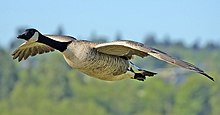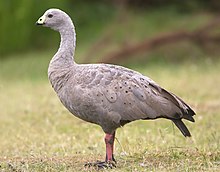Goose
| Geese | |
|---|---|
 | |
| Canada Goose, Branta canadensis | |
| Scientific classification | |
| Kingdom: | Animalia |
| Phylum: | Chordata |
| Class: | Aves |
| Superorder: | Galloanserae |
| Order: | Anseriformes |
| Family: | Anatidae |
| Subfamily: | Anserinae |
| Tribe: | Anserini |
| Genera | |
Anser
Branta Chenand see text | |
Geese are waterfowl belonging to the tribe Anserini of the family Anatidae. This tribe comprises the genera Anser (the grey geese), Branta (the black geese) and Chen (the white geese). A number of other birds, mostly related to the shelducks, have "goose" as part of their name. More distantly related members of the Anatidae family are swans, most of which are larger than true geese, and ducks, which are smaller.
Etymology
The word goose is a direct descendant of Proto-Indo-European root, *ghans-. In Germanic languages, the root gave Old English gōs with the plural gēs and gandra(becoming Modern English goose, geese, and gander, respectively), New High German Gans, Gänse, andGanter, and Old Norse gās. This term also gave Lithuanian žąsìs, Irish gé (goose, from Old Irish géiss),Latin anser, Greek chēn, Albanian gatë (heron), Sanskrit hans, Finnish hanhi, Avestan zāō, Polish gęś,
Russianгусь, Czech husa, and Persian ghāz
Russianгусь, Czech husa, and Persian ghāz
The term goose applies to the female in particular whilegander applies to the male in particular. Young birds before fledging are called goslings. The collective noun for group of geese on the ground is a gaggle; when in flight, they are called a skein, a team or a wedge; when flying close together, they are called a plump.
True geese
There are three living genera of true geese: Anser, grey geese, including the domesticated goose and the Swan Goose; Chen, white geese (often included in Anser); and Branta, black geese, such as the Canada goose.
Two genera of "geese" are only tentatively placed in the Anserinae; they may belong to the shelducks or form a subfamily on their own: Cereopsis, the Cape Barren Goose, and Cnemiornis, the prehistoric New Zealand Goose.
Either these or, more probably, the goose-like Coscoroba Swan is the closest living relative of the true geese.
Fossils of true geese are hard to assign to genus; all that can be said is that their fossil record, particularly in North America, is dense and comprehensively documents many different species of true geese that have been around since about 10 million years ago in the Miocene. The aptly named Anser atavus (meaning "Great-great-great-grandfather goose") from some 12 million years ago had even more plesiomorphies in common with swans. In addition, there are some goose-like birds known from subfossil remains found on the Hawaiian Islands.
Geese are monogamous, living in permanent pairs throughout the year; however, unlike most other permanently monogamous animals, they are territorial only during the short nesting season. Paired geese are more dominant and feed more, two factors that result in more young.
Other birds called "geese"
There are a number of mainly southern hemisphere birds called "geese", most of which belong to the shelduck subfamily Tadorninae. These are:
- Orinoco Goose, Neochen jubata
- Egyptian Goose, Alopochen aegyptiacus
- The South American sheldgeese, genus Chloephaga
- The prehistoric Madagascar Sheldgoose, Centrornis majori, the "Woodard"
The Blue-winged Goose, Cyanochen cyanopterus belongs either to these, or to lineage closer to ducks.
The Spur-winged Goose, Plectropterus gambensis, is most closely related to the shelducks, but distinct enough to warrant its own subfamily, the Plectropterinae.
The three species of small waterfowl in the genus Nettapus are named "pygmy geese", e.g. the Cotton Pygmy Goose (N. javanica). They seem to represent an ancient lineage like the Cape Barren Goose and the Spur-winged Goose.
A genus of prehistorically extinct seaducks, Chendytes, is sometimes called "diving-geese" due to their large size.
The unusual Magpie Goose is in a family of its own, the Anseranatidae.
The Northern Gannet, a seabird, is also known as the "Solan Goose" although it is a bird unrelated to the true geese, or any other Anseriformes for that matter.






No comments:
Post a Comment